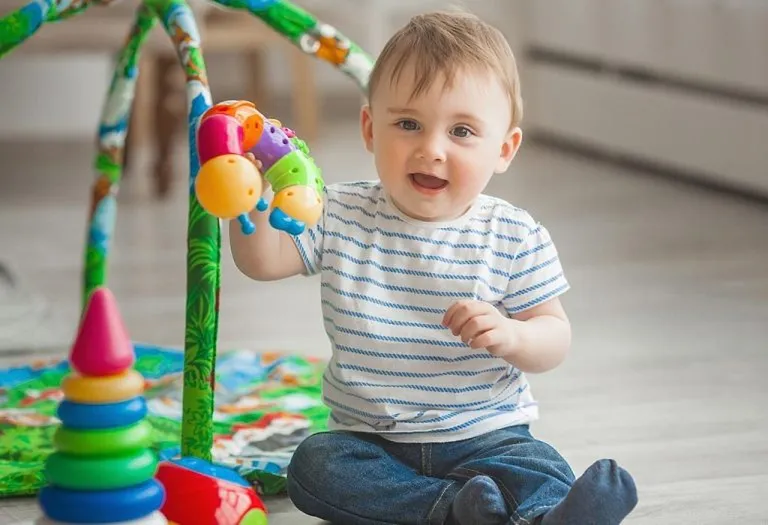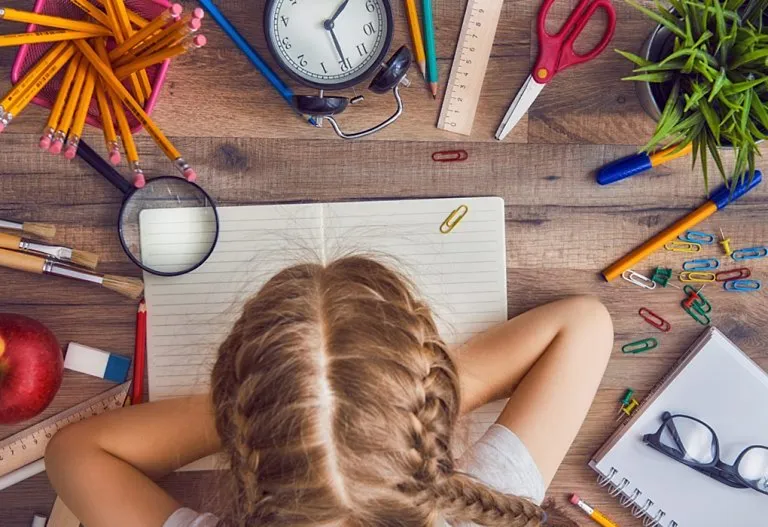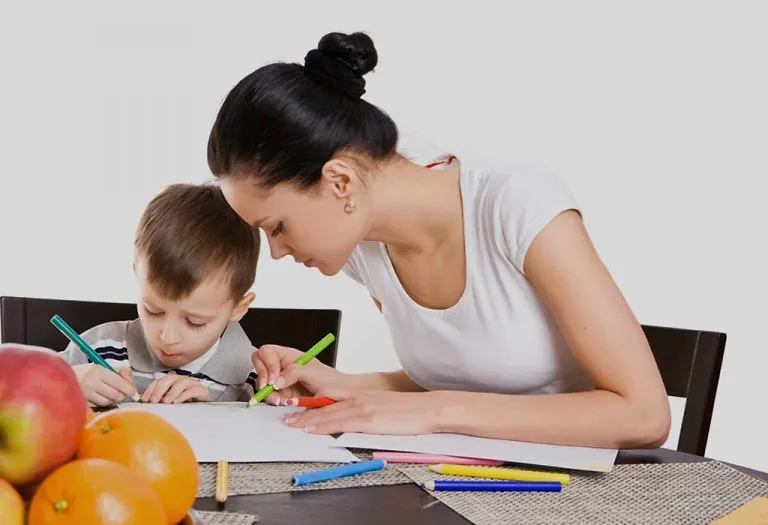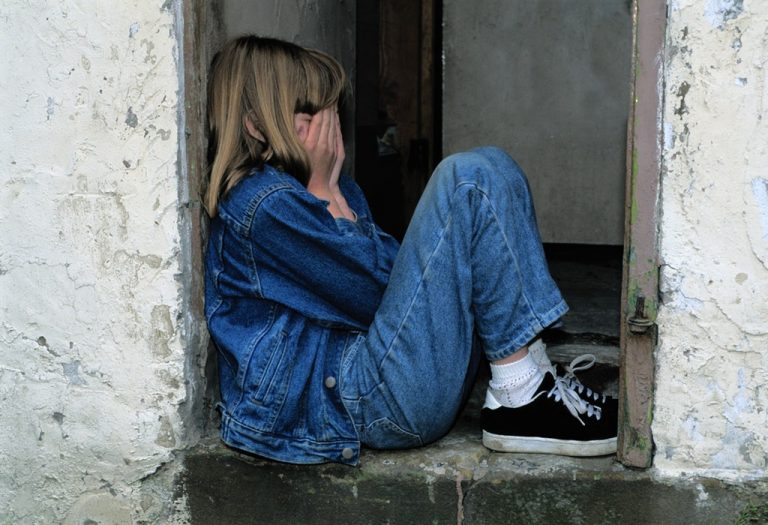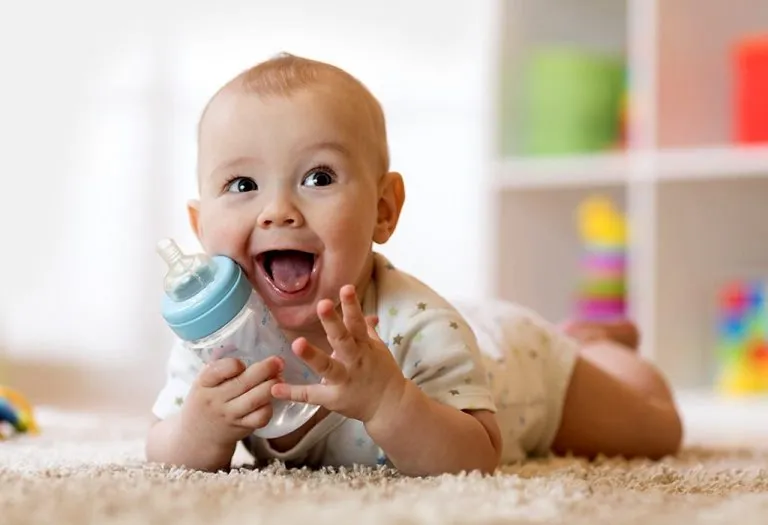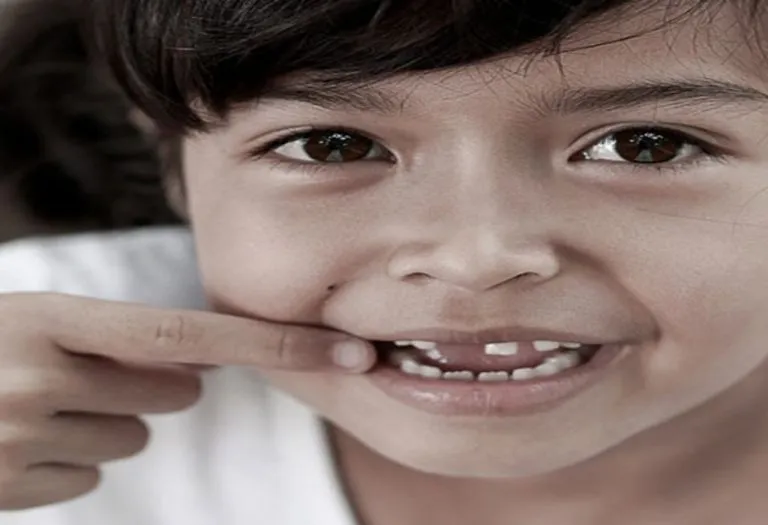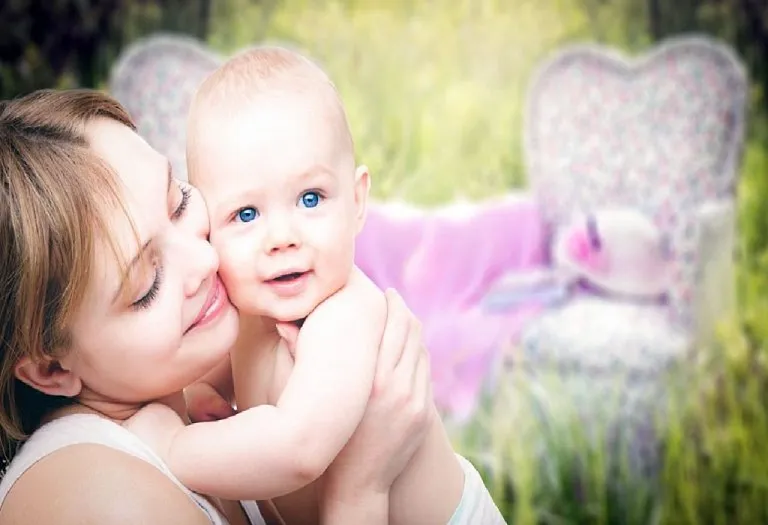Fine and Gross Motor Skills – Childhood Development

- What Are Fine Motor Skills?
- What Are Gross Motor Skills?
- Fine and Gross Motor Skills Development Activities
- Fine vs. Gross Motor skills
- Tips to Consider While Developing Fine and Gross Motor Skill
- FAQs
Once babies begin to hold and grab things around them, you know their motor skills are developing. Motor skills refer to the baby’s ability to make motions and movements, and they are classified as fine motor and gross motor skills. Fine motor skills involve small movements, like grasping toys or picking up tiny objects, while gross motor skills focus on larger movements, such as crawling or rolling over. Sometimes though, some babies need to be encouraged to practise holding toys or reaching for objects, which helps strengthen their coordination. Building these two skills appropriately means meeting important growth and development milestones in babies. Here, you’ll understand the types of motor skills, how they function, and when they typically develop.
What Are Fine Motor Skills?
Fine motor skills are small movements made by a baby and involve relatively smaller muscles of your baby’s body. A baby, wrapping his fingers around the finger of a parent, a baby holding and picking up small objects, or a baby trying to move his lips and tongue to ingest food or taste something are also examples of fine motor skills.
What Are Gross Motor Skills?
Gross motor skills are those movements made by a baby which are larger and involve the movements of the larger muscles of your baby’s body. A baby moving his arms to reach for a toy, a baby trying to sit upright, crawl or roll, all require the baby to move the larger muscles of the arms, legs, shoulders and torso, and are, therefore, classified as gross motor skills.
Now that we understand how these motor skills help babies, let’s take a look at how parents can help their babies develop them.
Fine and Gross Motor Skills Development Activities
Fine motor activities are those activities that aid and assist the development of fine motor skills in children and babies. These activities focus on improving hand-eye coordination by focusing on more precise and delicate movement involving the use of smaller muscle sets. One of the easiest activities is to give a child a handful of modelling clay. When a child starts playing with the modelling clay, he will squeeze the dough or try to roll or shape it using his fingers and will develop fine motor skills.
Gross motor activities are those activities that aid and assist in the development of gross motor skills in children and babies. These activities focus on improving the movements of larger muscle sets by engaging in activities that involve larger movements. Some activities that help develop gross motor skills include setting up an object as a target and encouraging the child to hit it by throwing softballs at it.
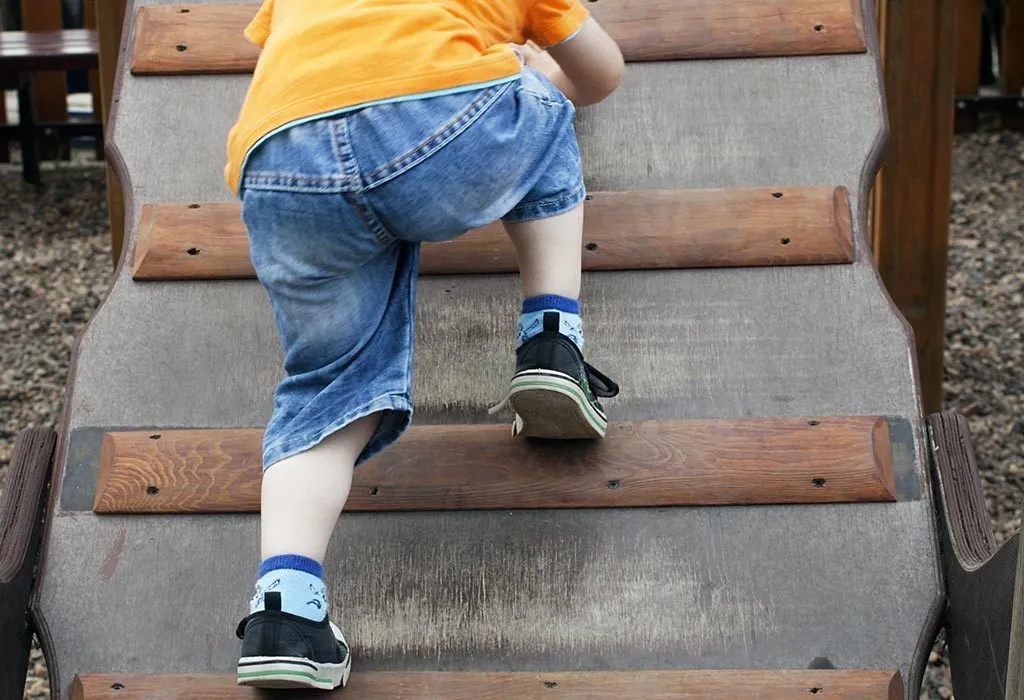
We have categorised activities according to certain age groups for your convenience.
1. Babies and Toddlers
- Babies that are 2-4 months old develop the grasp reflex and should be given small objects that they can hold in their hands. Ensure the objects are not so small that they can be swallowed unknowingly. It might take some time for the baby to hold the object, but eventually, he will grasp it involuntarily.
- Between the ages of 4-8 months, babies should be encouraged to play with small objects. They would now transfer objects from one hand to the other, easily pick up medium-sized objects and can also put them in their mouths or pull them out of containers. To avoid choking hazards, you must avoid any small object that can be swallowed accidentally.
- At 7-9 months of age, babies have an improved ability to reach forward and sidewards. They should be encouraged to reach for small objects by placing them at a small distance from the baby. Babies can also now place objects in containers and should be encouraged with activities that involve the same.
- By 12 months of age, babies should be encouraged with activities that involve pointing and poking. Also, activities involving picking up crayons and other slender objects as babies are now learning to use their thumbs.
- By the time they are eighteen months, babies can hold crayons and activities like drawing and colouring should be encouraged.
2. Preschoolers or Kindergarten
A few gross and fine motor activities for preschoolers are listed below:
- More activities involving drawing and colouring should be encouraged.
- Kids should be encouraged to use the spoon while eating.
- Should be taught to put on and take off shoes and socks.
- Should be encouraged to indulge in activities that involve the stacking of large objects.
- Although still difficult, a child can be taught to string beads.
- Playing with modelling clay should be encouraged.
- Can be taught to cut paper using scissors.
- Games involving the throwing of balls should be initiated.
- Should be taught to draw vertical and horizontal lines.
- Should be encouraged to dress and change clothes independently.
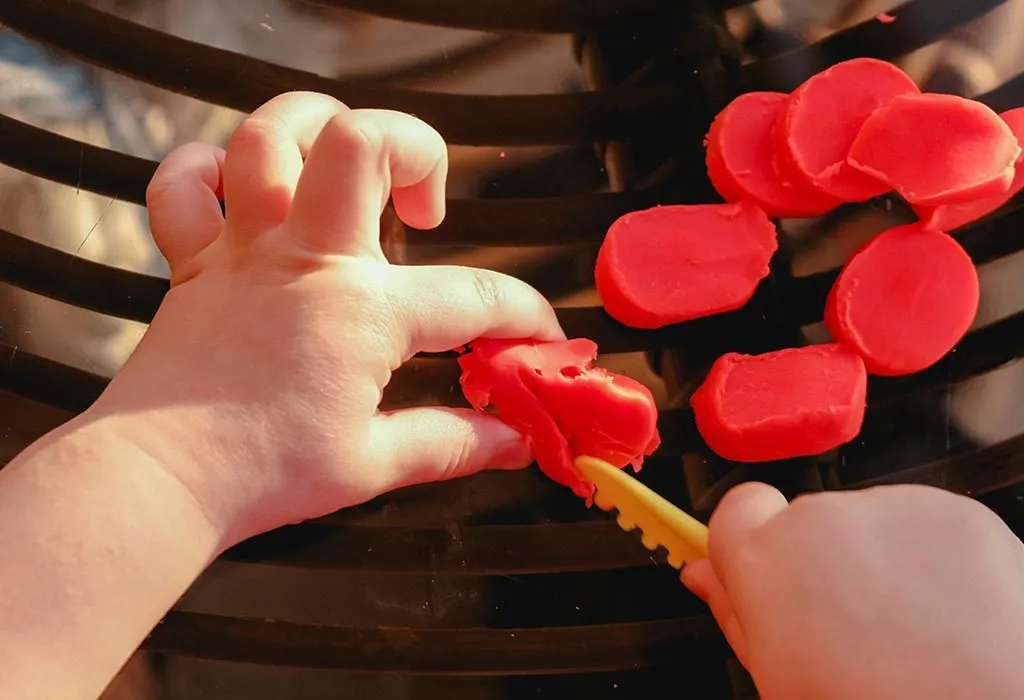
Fine vs. Gross Motor skills
- Gross motor skills involve the use of larger muscle sets for larger movements, activities, like sitting, crawling, rolling. Fine motor skills involve the use of small muscle sets for smaller, more delicate movements, grasping, picking up small objects are examples of fine motor skills.
- Gross, as well as fine motor skills, start developing during infancy (by 4 months of age). Grasping of toys, transferring of objects, and pincer grasp are some examples of fine motor skills that develop with the gross motor skills.
- Both gross and fine motor skills can be developed by indulging the baby in some activity or games.
- Proper nutrition and a stimulating environment play a vital role in fostering the healthy development of both fine and gross motor skills.
- Gross motor skills support mobility and balance, helping babies walk, climb stairs, or dance, while fine motor skills enable detailed tasks like holding a spoon, drawing, or buttoning clothes, fostering independence.
- Exposure to sensory activities, such as playing with sand, water, or textured toys, can simultaneously stimulate the development of both fine and gross motor skills.
Tips to Consider While Developing Fine and Gross Motor Skill
Fine and gross motor skills are crucial for daily tasks, mobility, and independence, and they can be nurtured through simple activities and exercises. Here are some practical tips to help your child improve both skill sets effectively.
1. Encourage Tummy Time
Tummy time helps strengthen your baby’s core, neck, and shoulder muscles, which are essential for gross motor skills like rolling and crawling. Aim for short, supervised sessions daily.
2. Provide Age-Appropriate Toys
Introduce toys like stacking blocks, shape sorters, or puzzles to help develop fine motor skills, while balls or push toys can support gross motor skill growth.
3. Incorporate Outdoor Play
Outdoor activities, such as running, jumping, or climbing, promote gross motor skill development while engaging the child’s larger muscle groups.
4. Practice Hand-Eye Coordination Activities
Activities like drawing, threading beads, or tossing and catching a ball enhance both fine and gross motor coordination.
5. Use Everyday Tasks as Learning Opportunities
Encourage your child to perform age-appropriate tasks like buttoning clothes, pouring water, or feeding themselves to strengthen their fine motor skills naturally.
FAQs
1. How do fine and gross motor skills influence academic performance?
Fine motor skills are essential for tasks like writing and cutting, while gross motor skills support posture and balance, both of which are critical for focus and participation in classroom activities.
2. Are fine and gross motor skills hereditary?
While genetics can play a role in muscle tone and coordination, environmental factors, activities, and opportunities for practice significantly influence the development of motor skills.
3. Do bilingual children develop motor skills differently?
Bilingualism does not directly affect motor skill development, but the cognitive benefits associated with managing two languages can enhance overall brain development, indirectly supporting better coordination and problem-solving in motor tasks.
These were some great examples of fine and gross motor skills. Gross and fine motor skills are essential for your baby’s growth and development. While motor skills develop naturally, it is still advisable for parents to monitor their child’s development. Some activities, including playtime activities and games, can be used to develop both fine and gross motor skills. If certain motor skills are slow to develop, some activities can speed up their development. Remember that each child has his own pace of growth and development. If you see a delay in your little one’s development, you need not worry. Instead, consult a paediatrician, who can help you find better ways to bring about the development even if it is slightly delayed.
References/Resources:
1. Is Your Baby’s Physical Development on Track?; American Academy of Pediatrics; https://www.healthychildren.org/English/ages-stages/baby/Pages/Is-Your-Babys-Physical-Development-on-Track.aspx
2. Cava. P, Coffey. T, Perni. N; Children’s Developmental Milestones: Gross and Fine Motor Skills; Brown Health University; https://www.brownhealth.org/be-well/childrens-developmental-milestones-gross-and-fine-motor-skills
3. Gross Motor Skills; Cleveland Clinic; https://my.clevelandclinic.org/health/articles/gross-motor-skills
4. Gross motor skills: Birth to 5 years; Children’s Hospital of Richmond; https://www.chrichmond.org/services/therapy-services/developmental-milestones/gross-motor-skills-birth-to-5-years
5. Fine Motor Skills; Cleveland Clinic; https://my.clevelandclinic.org/health/articles/25235-fine-motor-skills
6. Fine motor skill development: Birth to 2 years; Children’s Hospital of Richmond; https://www.chrichmond.org/services/therapy-services/developmental-milestones/fine-motor-skills-birth-to-2-years
7. Developmental milestones: Fine motor skills and visual motor skills; Children’s Hospital of Orange County; https://www.choc.org/userfiles/file/Rehab-Developmental%20Milestones%20final.pdf
Also Read:
Physical Development in Children
Emotional Development in Infants
Major Stages of Child Development
Understanding and Encouraging a Baby’s Development
Was This Article Helpful?
Parenting is a huge responsibility, for you as a caregiver, but also for us as a parenting content platform. We understand that and take our responsibility of creating credible content seriously. FirstCry Parenting articles are written and published only after extensive research using factually sound references to deliver quality content that is accurate, validated by experts, and completely reliable. To understand how we go about creating content that is credible, read our editorial policy here.







